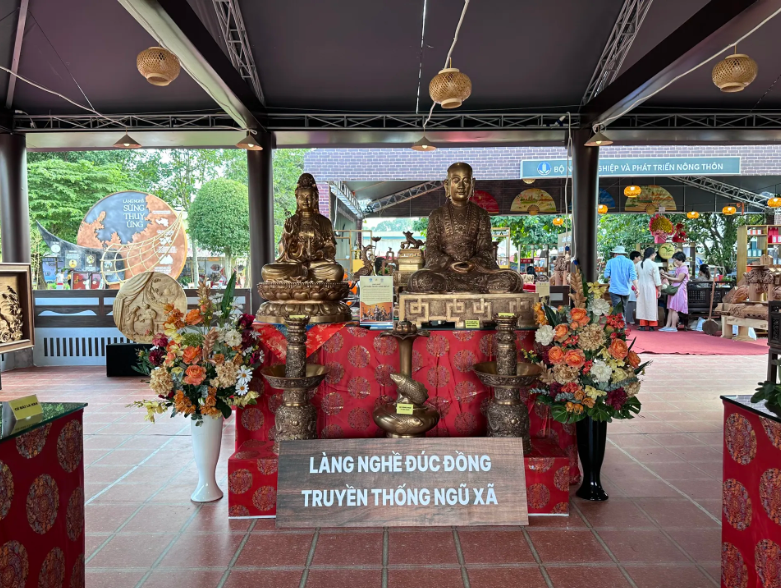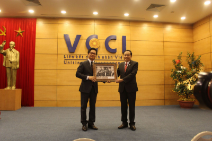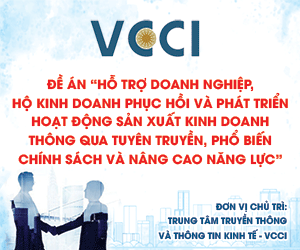Recognizing craft villages for preservation and sustainable development
As of early 2025, one-fourth of Hanoi's 1,350 craft villages were officially recognized by the city.
Hanoi has so far this year recognized an additional 14 villages with the titles of Craft Village, Traditional Craft Village, and Traditional Craft to establish a legal identity that forms the basis for preserving, developing, and supporting production in these villages.
Honor and responsibility
Ngu Xa Village, located in Truc Bach Ward of Hanoi’s Ba Dinh District, is renowned for its centuries-old tradition of bronze casting. The village’s skilled artisans have produced works that are now integral to Vietnam’s cultural heritage. Among the most notable are the statue of Tran Vu at Quan Thanh Temple, one of the Four Sacred Temples of ancient Thang Long (Hanoi today), and the 14-ton statue of Amitabha Buddha at Ngu Xa Pagoda, officially recognized as a masterpiece of Vietnamese culture and art.

Ngu Xa Traditional Bronze Casting Village participates in the 2023 Festival for the Preservation and Development of Vietnamese Craft Villages. Photo: Viet An/The Hanoi Times
Continuing this legacy, artisan Bui Thi Minh and her children and grandchildren have preserved and promoted the craft of bronze casting. Four members of her family have been awarded the title of "Hanoi Artisan". In 2024, Hanoi recognized Ngu Xa as a "Traditional Craft."
This is both a great honor and a heavy responsibility. It motivates us to continue to preserve and share the traditional crafts of our village, despite the many challenges and the risk of their oblivion," Minh said.
Nguyen Thi Phuong, Head of Gie Thuong Village (Phu Yen Commune, Phu Xuyen District), which has just been recognized as a “Traditional Craft Village,” proudly shared that the village's leather shoe production involves 350 households and about 1,000 workers. In recent years, the craft has flourished, generating significant income for many families and helping Phu Yen Commune become a model new rural area.
Rural industries and traditional craft villages have a long history and play an important role in economic and social development, as well as in cultural heritage preservation.
Nguyen Dinh Hoa, Deputy Director of Hanoi's Department of Agriculture and Environment, said that in 2024, the city conducted three rounds of official recognition, granting titles to 14 craft villages. Among them, Van An Carpentry Village in Son Dong Commune in Son Tay City, Hat Mon Carpentry Village in Hat Mon Commune in Phuc Tho District, and Chung Chan Tailoring Village in Van Tu Commune in Phu Xuyen District were awarded the title of "Hanoi Craft Village."

Long-lasting traditional craft villages play an important role in Hanoi's economic and social development. Photo: The Hanoi Times
Other villages were recognized for their preservation of traditional skills: Co Chat Embroidery Village in Dung Tien Commune in Thuong Tin District, Gie Ha and Gie Thuong Leather Shoe Villages in Phu Yen Commune in Phu Xuyen District, and Quang Ba Lotus Tea Fragrance Village in Quang An Ward, Tay Ho District were awarded the title of "Traditional Craft Village."
Besides, several time-honored crafts and artisanal practices were accredited as "Traditional Crafts of Hanoi," including Hang Than green sticky rice flakes and Ngu Xa bronze casting in Truc Bach Ward, Ba Dinh District, Ba Duong Noi kite making in Hong Ha Commune, Dan Phuong District, Dinh Cong gold and silver work in Dinh Cong Ward, Hoang Mai District, Vong green sticky rice flakes in Dich Vong Hau Ward, Cau Giay District, and Quang An lotus tea scenting in Quang An Ward, Tay Ho District.

Foreign visitors are fascinated by Hanoi's traditional craft village products. Photo: Trong Tung/The Hanoi Times
More support
To promote the development of craft villages and rural industries, Hanoi has introduced various programs and policies in recent years. These include boosting exports of craft products, supporting preservation and development efforts, integrating craft villages with tourism, preserving and promoting cultural heritage, encouraging specialized agricultural production areas, and advancing the transformation of craft villages.
From 2025 to 2030, Hanoi aims to restore and preserve at least five endangered traditional crafts and villages, recognize at least 10 new crafts and 25 new craft villages, and upgrade 10 existing craft villages to traditional craft village status. To achieve this, the city will continue to implement supportive policies, with a focus on the “Comprehensive Project for the Development of Craft Villages in Hanoi for 2025–2030, with Vision to 2050.”
In addition to support at the city level, Deputy Director Nguyen Dinh Hoa emphasized the need for localities to promote recognized craft villages and link them to the One Commune One Product (OCOP) program to establish craft tourism destinations.
"For existing craft villages, further efforts would focus on sustainable production, expanding scale, improving product design and quality, applying technology, and strengthening promotion to ensure more effective development," Hoa said.








